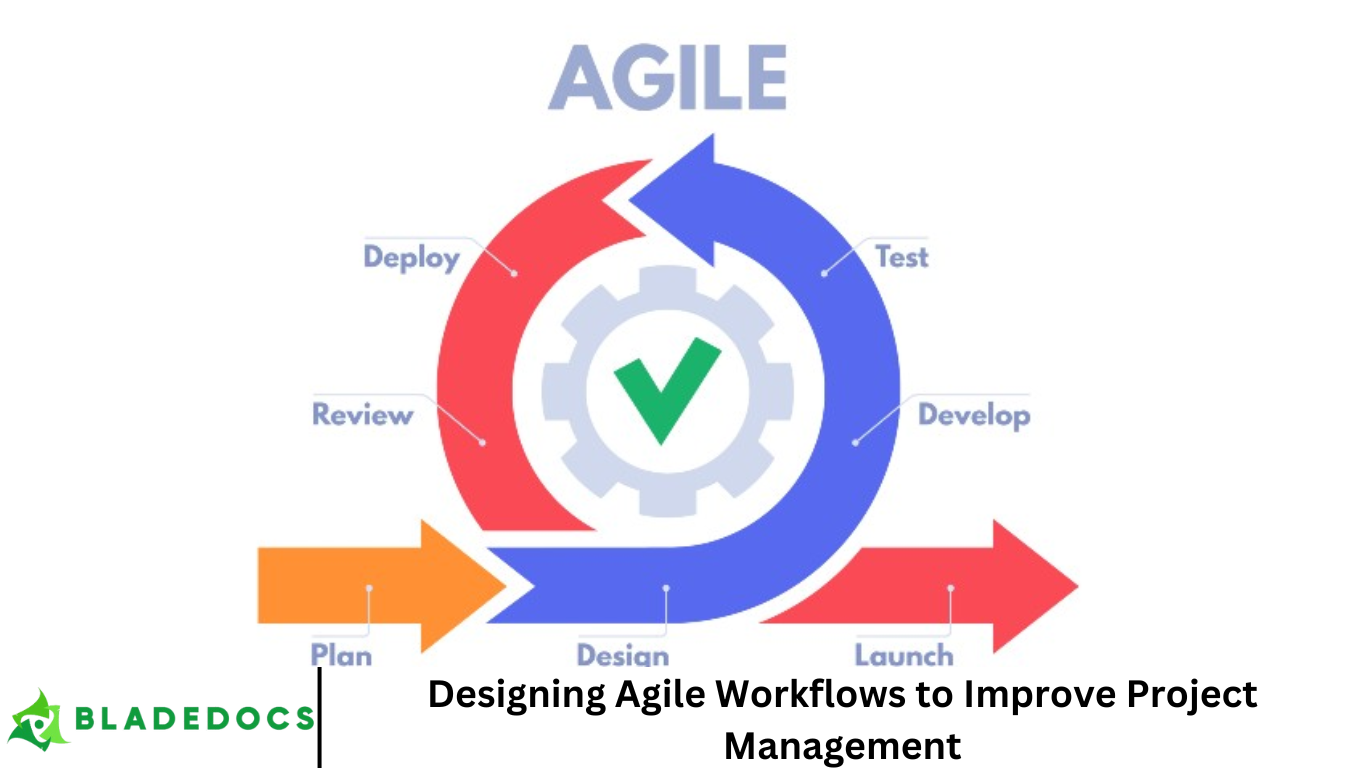Dynamic business environment, organizations face growing pressure to deliver high-quality products and services faster and more efficiently. Agile methodologies have emerged as a leading approach to address these challenges by promoting flexibility, collaboration, and iterative progress.
Central to the success of Agile is the creation of effective workflows. Designing Agile workflows is critical for improving project management outcomes, ensuring alignment with business goals, and enhancing team productivity.
We will explore the fundamentals of Agile workflows, their role in project management, and best practices for designing workflows that drive success.
More Read: Creating an Effective User Manual: A Step-by-Step Guide
What is an Agile Workflow?
An Agile workflow is a structured yet flexible framework that guides the movement of tasks through different stages of a project lifecycle. It outlines how work is initiated, developed, reviewed, and completed within an Agile team.
Unlike traditional linear project management models, Agile workflows are iterative and adaptive, allowing teams to respond quickly to changing requirements and customer feedback.
Agile workflows typically involve stages such as backlog grooming, sprint planning, development, testing, review, and deployment. These workflows are supported by Agile practices like Scrum or Kanban and can be customized to fit the unique needs of a team or organization.
Benefits of Agile Workflows in Project Management
1. Improved Flexibility and Responsiveness
Agile workflows empower teams to adapt to changing priorities and requirements. This flexibility enables organizations to respond to market demands more effectively, reducing time to market and improving customer satisfaction.
2. Enhanced Collaboration and Communication
By promoting transparency and frequent communication, Agile workflows help teams work together more effectively. Daily stand-ups, sprint reviews, and retrospectives ensure that everyone is aligned and working toward shared goals.
3. Increased Productivity and Efficiency
Agile workflows streamline task management, reduce bottlenecks, and eliminate unnecessary steps. This leads to better resource allocation, faster task completion, and overall improved team performance.
4. Better Risk Management
The iterative nature of Agile allows for continuous monitoring and risk assessment. Issues can be identified early and addressed before they escalate, reducing the likelihood of project failure.
5. Higher Quality Deliverables
Frequent testing and reviews built into Agile workflows ensure that issues are caught early and that the final product meets quality standards. Continuous integration and delivery practices also contribute to higher quality outcomes.
Key Components of an Agile Workflow
1. Product Backlog
The product backlog is a prioritized list of features, enhancements, bug fixes, and technical tasks. It serves as the central source of work for the Agile team and is continuously refined through backlog grooming sessions.
2. Sprint Planning
During sprint planning, the team selects items from the product backlog to complete during the upcoming sprint. This meeting defines the sprint goal and establishes a clear plan for the work ahead.
3. Task Execution
Tasks are broken down into manageable units and assigned to team members. Agile encourages self-organizing teams, meaning individuals take ownership of their work and collaborate to achieve sprint goals.
4. Daily Stand-Ups
These short, daily meetings help teams stay synchronized. Team members share progress, discuss roadblocks, and plan their day, ensuring alignment and accountability.
5. Sprint Review and Demo
At the end of each sprint, the team presents completed work to stakeholders. This provides an opportunity for feedback and ensures that deliverables align with expectations.
6. Sprint Retrospective
The retrospective is a critical Agile ceremony where the team reflects on what went well, what didn’t, and how to improve. It fosters a culture of continuous improvement.
7. Kanban Board or Scrum Board
Visual tools like Kanban or Scrum boards help track task progress and identify bottlenecks. These boards typically include columns like “To Do,” “In Progress,” and “Done.”
Steps to Design an Effective Agile Workflow
1. Understand Your Team’s Needs
Begin by assessing your team’s size, skillset, and work style. Different teams may benefit from different Agile frameworks (e.g., Scrum vs. Kanban). Choose an approach that aligns with your team’s characteristics and project requirements.
2. Define Workflow Stages
Clearly outline each stage of your workflow. This could include stages like “Ready for Development,” “In Development,” “Code Review,” “Testing,” and “Done.” Each stage should represent a specific step in the value delivery process.
3. Establish Clear Roles and Responsibilities
Agile emphasizes accountability and ownership. Define roles such as Product Owner, Scrum Master, and Development Team members. Clarify who is responsible for what at each stage of the workflow.
4. Use Agile Tools and Software
Leverage Agile project management tools like Jira, Trello, Asana, or Monday.com. These tools help visualize workflows, manage backlogs, and track sprint progress.
5. Incorporate Feedback Loops
Design your workflow to include regular feedback loops, such as sprint reviews and retrospectives. Feedback should come from both team members and stakeholders to ensure continuous improvement.
6. Monitor and Adjust
Agile workflows are not set in stone. Regularly evaluate their effectiveness and make adjustments as needed. Use performance metrics like velocity, cycle time, and team satisfaction to guide improvements.
Common Challenges and How to Overcome Them
1. Resistance to Change
Introducing Agile workflows often requires a cultural shift. Provide training, highlight the benefits, and involve team members in the design process to foster buy-in.
2. Lack of Clear Goals
Without a well-defined vision and objectives, workflows can become unfocused. Ensure that each sprint and task is tied to clear business goals.
3. Inconsistent Practices
Agile requires consistency to be effective. Establish standard operating procedures and ensure that everyone follows them.
4. Overcomplication
Avoid overengineering your workflow with too many stages or unnecessary steps. Keep it as simple as possible while still covering all necessary phases of work.
5. Poor Communication
Agile thrives on communication. Encourage open dialogue, provide collaboration tools, and maintain a culture of transparency.
Measuring the Success of Agile Workflows
To determine whether your Agile workflows are effective, consider tracking the following metrics:
- Velocity: Measures the amount of work a team completes during a sprint.
- Cycle Time: The time it takes for a task to move from start to finish.
- Burndown Charts: Visual representation of remaining work in a sprint.
- Team Satisfaction: Regular feedback from team members about the workflow.
- Defect Rates: Tracks the number of bugs or issues in deliverables.
Analyzing these metrics helps identify areas for improvement and optimize workflows for better results.
Frequently Asked Question
What is an Agile workflow in project management?
An Agile workflow is a structured, iterative process that guides how tasks move through different stages of a project—such as planning, development, testing, and delivery. It supports flexibility, rapid feedback, and continuous improvement, making it ideal for dynamic and collaborative project environments.
How does designing Agile workflows improve project management?
Well-designed Agile workflows enhance transparency, streamline communication, and enable teams to respond quickly to changes. They also promote better task tracking, risk management, and alignment with business goals—leading to more successful project outcomes.
What’s the difference between Scrum and Kanban workflows?
- Scrum uses time-boxed sprints with fixed goals and roles (Scrum Master, Product Owner, etc.).
- Kanban focuses on continuous delivery and visualizing tasks on a board without fixed iterations.
The choice depends on your team’s workflow preference and project type.
What tools can help in designing and managing Agile workflows?
Popular Agile tools include Jira, Trello, Asana, Monday.com, and ClickUp. These tools offer features like drag-and-drop boards, backlog management, sprint planning, and real-time collaboration to help teams implement and optimize workflows.
How often should Agile workflows be reviewed or updated?
Agile workflows should be reviewed at the end of every sprint or iteration during the retrospective meeting. Regular reviews help identify inefficiencies and allow teams to adapt and improve their processes continually.
What are the most common mistakes when creating Agile workflows?
- Overcomplicating the process with too many stages
- Ignoring team feedback
- Inconsistent use of Agile tools
- Lack of clear goals or role definitions
Avoiding these pitfalls ensures smoother implementation and better results.
Can Agile workflows be used outside of software development?
Yes, Agile workflows are increasingly used in marketing, HR, product design, education, and more. Any project-based work that benefits from flexibility, collaboration, and iterative improvement can adopt Agile workflows successfully.
Conclusion
Designing Agile workflows is essential for effective project management in modern software development. A well-structured Agile workflow enhances flexibility, boosts productivity, and ensures that teams deliver value consistently. By understanding your team’s needs, defining clear stages, using the right tools, and embracing continuous improvement, you can create workflows that drive project success. As Agile continues to evolve, staying committed to refining your workflows will help your organization remain competitive and responsive in a fast-paced digital landscape. Embrace Agile workflows, and transform your project management practices for the better.


